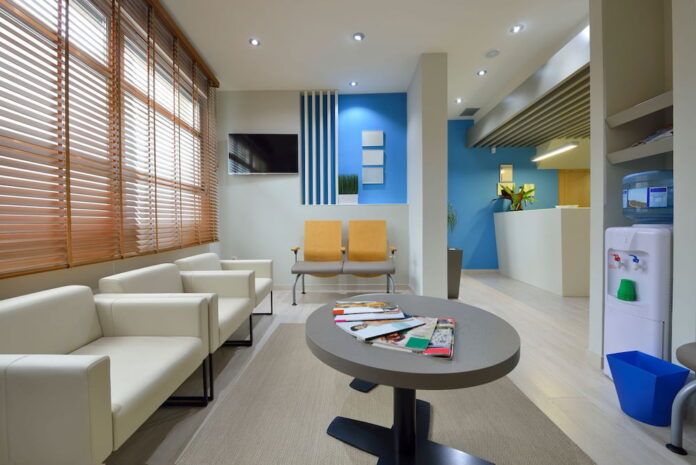A clinic’s waiting room serves as patients’ first point of contact, setting the tone for their entire experience. As such, designing an impressive waiting room not only demonstrates a commitment to professionalism and patient care but also creates a calming and welcoming environment that may help alleviate anxiety and promote relaxation.
This article explores key aspects of designing an impressive waiting room to help you create a functional and inviting space for your patients. Read on.
1- Prioritize Comfort And Seating Arrangements
Your patients’ comfort should be a top priority when designing a waiting room. So, investing in high-quality, comfortable chairs that provide ample back support is highly recommended. It’s also best to add a mix of seating options, like chairs with armrests, loveseats, or benches, to accommodate different preferences and needs. However, avoid overcrowding the space and only provide enough seating to accommodate the number of patients you typically serve.
Adding rugs improves the look of your clinic, although very small, investing in rugs online sydney can add decorative look to your clinic.
2- Provide Adequate Privacy And Noise Reduction
Privacy is crucial in a medical setting, and your waiting room should be no exception. To ensure patient confidentiality, use partitions or screens to create designated areas for private conversations or sensitive procedures.
You may also use noise-reducing materials such as acoustic panels and wall and floor coverings to minimize the transfer of sound throughout the space. Carpets and rugs, for example, are known to soften harsh sounds and create a more peaceful and quieter indoor environment. As such, consider installing a carpet or incorporating rugs in your waiting room’s flooring to eliminate excessive noise from shoe heels, footfalls, or chairs scraped across the floor.
However, since rugs and carpets can easily accumulate dirt and dust, ensure they are thoroughly cleaned regularly. So, have a read and learn more about hiring a professional rug cleaning specialist to maintain and clean your waiting room’s rugs on your behalf.
3- Embrace Natural Light And Airy Spaces
Natural light and well-ventilated spaces can positively impact patients’ moods and well-being. When possible, incorporate large windows to allow natural light and fresh air to flow into your waiting room.
But if your clinic is located in a building with limited access to natural light, consider using light fixtures that mimic sunlight to create a similar effect. Moreover, ensure your waiting room has proper ventilation and air circulation to maintain a fresh and healthy environment.
4- Use Calming Colors And Artwork
The choice of color in your waiting room can significantly influence the space’s ambiance. That said, consider opting for calming colors, such as soft blues, greens, and earth tones, which can promote relaxation and serenity. And as much as possible, avoid overly bright or intense colors, as these can potentially increase anxiety levels.
You may also add artwork in your waiting room to spruce up the space. However, opt for nature scenes or abstract paintings to provide a sense of tranquility instead of displaying images that may be anxiety-inducing.
5- Offer Entertainment and Amenities
Providing entertainment and amenities can be a great way to keep patients relaxed while waiting for their appointment. So, consider setting up a designated area with a television or monitor that streams calming videos or informative health-related content. You may also offer a variety of reading materials, such as magazines and educational brochures, to cater to diverse interests and age groups.
Additionally, ensure that your waiting room is equipped with complimentary Wi-Fi, charging stations, and outlets so patients can use their electronic devices while waiting.
6- Designate A Children’s Area
If your clinic serves pediatric patients or families, creating a designated children’s area within your waiting room is recommended. This space could include child-friendly seating, toys, books, and educational materials to keep young patients entertained and engaged. By offering a designated area for children, you can help reduce noise levels and ensure your waiting room remains a relaxing environment for patients of all ages.
7- Consider Accessibility And Inclusivity
When designing your waiting room, it’s also essential to consider accessibility and inclusivity. This means ensuring there is ample space for wheelchair users to navigate comfortably and that seating options cater to individuals with different mobility needs. Installing handrails strategically and using clear, easy-to-read signage to indicate restrooms, exits, and other important areas are also crucial.
Additionally, consider providing visual, auditory, and tactile aids for patients with visual or hearing impairments.
8- Ensure Consistency With Your Clinic’s Branding
Your waiting room should be consistent with your clinic’s branding and overall aesthetic. This means that the space should give patients a glimpse of what to expect during their visit and reflect the values and professionalism of your practice. To do this, use consistent colors, materials, and design elements throughout your clinic to create a cohesive space and memorable patient experience.
9- Use Greenery And Nature Elements
Incorporating greenery and natural elements into your waiting room design is another way to help create a calming and therapeutic environment. For instance, you can introduce indoor plants as they’re known for their air-purifying qualities. You can also use natural wood, stone, or bamboo to create a more organic and soothing atmosphere.
10- Keep The Space Clean And Organized
Lastly, a clean and organized waiting room is essential for creating a positive first impression and maintaining a professional atmosphere. To achieve this, ensure the space is regularly cleaned and sanitized, paying special attention to high-touch surfaces like chairs, door handles, and countertops. You can also provide hand sanitizer dispensers and tissues for your patient’s convenience.
Furthermore, keep the waiting room clutter-free by using storage solutions such as shelving, cabinets, or storage bins to organize reading materials, toys, and other items.
Wrap Up
Designing an impressive waiting room for your clinic requires careful planning and attention to detail. By prioritizing comfort, creating a calming atmosphere, and ensuring accessibility and inclusivity, you can create a space that enhances the patient’s experience, reflects the high standards of your practice, and eventually encourage more patients to your clinic. Moreover, keep your waiting room clean, organized, and consistent with your clinic’s branding to leave a lasting positive impression on your patients.
Read Also
- How Elderly Live-In Care Supports IndependenceWhat does it mean to stay independent as we age? Many older adults want to remain in their homes, where they feel safe and comfortable. Live-in care offers a way to make this possible. With a caregiver’s help, daily needs can be met without losing freedom. It allows seniors to keep routines while getting the… Read more: How Elderly Live-In Care Supports Independence
- Benefits of Enrolling in Botox Training CoursesMany people want to enhance their skills in the beauty field, and one way to do that is through Botox training. With the rising popularity of Botox, enrolling in training courses can set you on a path to a rewarding career. If you are considering this option, you might be curious about the benefits that… Read more: Benefits of Enrolling in Botox Training Courses
- Comparing 2025 Dental Practice Management Software OptionsSoftware Key Strengths Potential Limitations Best For Dentimax • Offers both cloud-based and on-premise/server deployment. • Tight integration between imaging (e.g. X-ray sensors) and practice management, charts, treatment planning, imaging all in one. • Transparent pricing and relatively simple UI/usability; solid for small to medium general practices. • May lack some of the… Read more: Comparing 2025 Dental Practice Management Software Options
- Modern Approaches to Brain Tumor Treatment and CareBrain tumors are serious and complex, but today’s treatments offer more hope than ever. Thanks to new technology and medical advances, doctors can treat brain tumors more safely and effectively. Patients also receive better care that focuses on their whole well-being, not just the disease. Read on and learn more! New Ways to Treat Brain… Read more: Modern Approaches to Brain Tumor Treatment and Care
- Custom Medication Solutions: Enhancing Personalized Patient CareDid you know that the global personalized medicine market is expected to hit around $1315.43 billion by 2034? This shows the rising demand for treatments tailored to patient needs. Personalized healthcare is now more important than ever. Each patient has unique genetics, lifestyles, and health challenges. Knowing these differences helps deliver care that works. Custom… Read more: Custom Medication Solutions: Enhancing Personalized Patient Care
- Facials for Sensitive or Rosacea-Prone SkinDelivering effective facials for sensitive or rosacea-prone skin requires a comprehensive approach. From initial consultation to post-treatment care, understanding client needs is crucial. Tailored facials not only address skin concerns but also enhance overall well-being. When considering the best practices for facials, you must focus on creating a seamless and customized experience for individuals with… Read more: Facials for Sensitive or Rosacea-Prone Skin







